Low-growing (superdeterminate) tomatoes: the best varieties for open ground and greenhouses
For a long time, undersized varieties of tomatoes, especially loved for the earliest possible harvest, have firmly entered the life of amateur gardeners. However, the correct choice of the most suitable varieties for open ground and greenhouses remains fundamental. What are low-growing tomatoes, what are the advantages and disadvantages of growing them, as well as the 25 best varieties that are of greatest interest to amateur vegetable growing, will be discussed below.
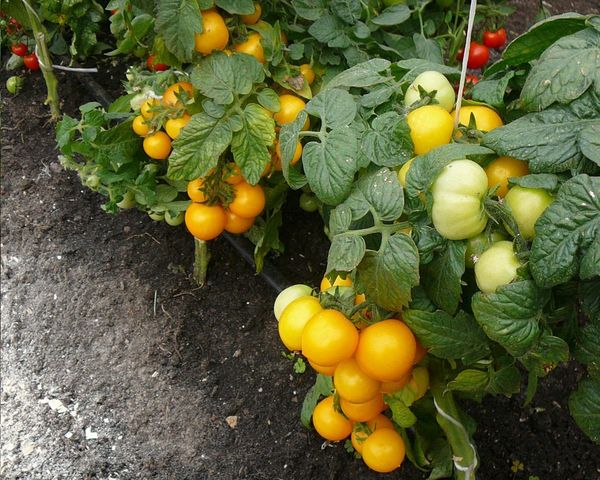
Content
What are undersized tomatoes and the benefits of growing them
Determinant varieties of tomatoes are called stunted, in other words, those varieties that have limited growth.
Tall - this indeterminate varietiesthat have no growth restrictions.
Conventional determinant varieties stop growing after 3-5 (sometimes 6) flower clusters are laid, and the latter is formed at the very top, and then the growth stops. Most often, the first brush is laid over 5-7 sheets, and all subsequent ones - every 1-2 sheets. The finalthe height of such a bushremains within 60-150 cm.
However, it is undersizedare usually called superdeterminate varieties of tomatoes whose height does not exceed 60 cm... Besides, growth they have ends after formation 3 brushes.
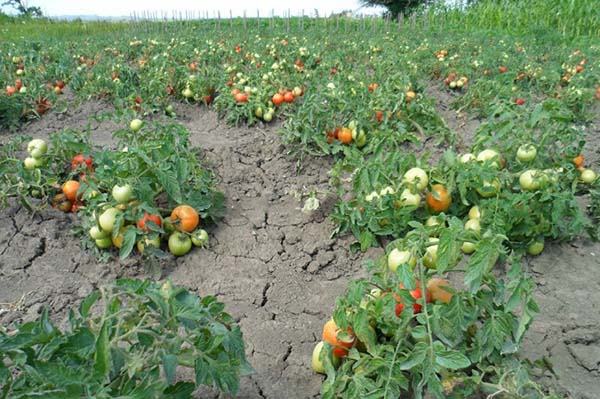
Particularly popular among the determinant undersized varieties are theirstandard varieties that havethickened short stem... It is these bushes, as a rule,do not require garters and pinning, but it is better to do it all the same.
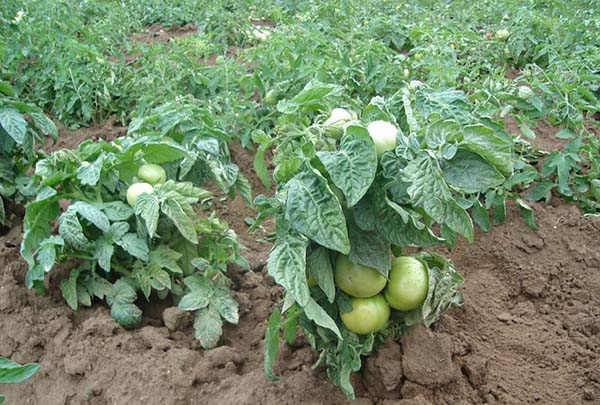
Advantages and disadvantages
The advantages of growing low-growing varieties of tomatoes:
- begin to bear fruit early (early ripening);
Superdeterminant (including standard ones) begin their fruiting 5-10 days earlier than just determinant ones.
- have a compact design = more convenient to care for, moreover, they do not take up much space (can and should be planted close);
- practically do not form stepchildren, which means that you almost never need them pinch;
By the way! Many experienced summer residents still remove the lowest 2-3 stepsons.
Superdeterminant varieties limit their growth for the most part immediately after the formation of the first flower brush, and all subsequent ones appear in the stepsons and, therefore, stepsons can be removed only up to the first flower brush (usually there are just 2-3 of them before it).
- if it's undersized standard variety, then it does not even need to be tied up additionally.
However! Many do not tie up and ordinary (not standard) superdeterminate varieties... But it should be said that it is always better to tie up than not to.
- differ in amicable fruiting, i.e. the crop ripens at the same time;
- do not have time to get sick late blightsince end their fruiting before its active phase;
- ideal for outdoor cultivation;
By the way! Also undersizedtomatoes can be grown at home: on a windowsill or on a balcony.
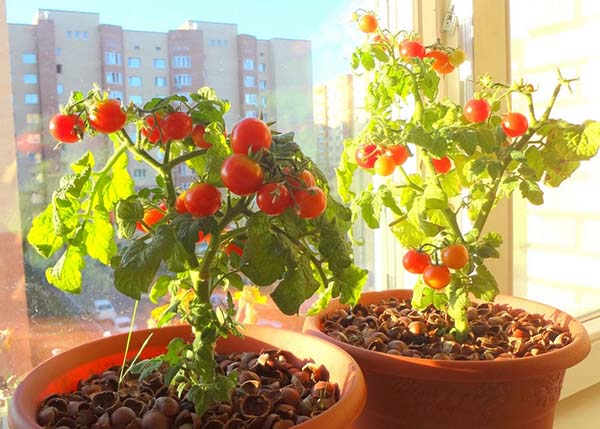
- some varieties and hybrids can be grown in a seedless way (direct sowing into the ground).
- can be grown in cold regions with short summers (for example, in the north, in the same Siberia).
Features of growing undersized tomatoes
Low-growing tomatoes are mostly grown outdoors, for which they are just perfect (see their benefits in the paragraph above). But to get an even earlier crop of tomatoes, you can plant them in a low greenhouse or a film greenhouse on arches.
As a rule, it is written on packs with seeds of low-growing varieties of tomatoes that they do not need garter and pinching (shaping).
However! Garter advantage is that when the plant is standing and not lying on the ground, the fruits are of higher qualitysince they do not touch the ground, which means they will not be one-sided (one is old red, and the other is yellow or green).
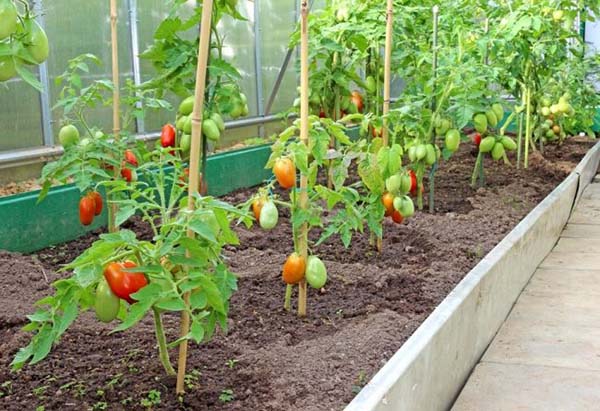
However! If you want to get the earliest and most worthy harvest, then shaping and pinning undersized (superdeterminate) tomatoes required.
Schemes for the formation of superdeterminant (undersized) tomatoes:
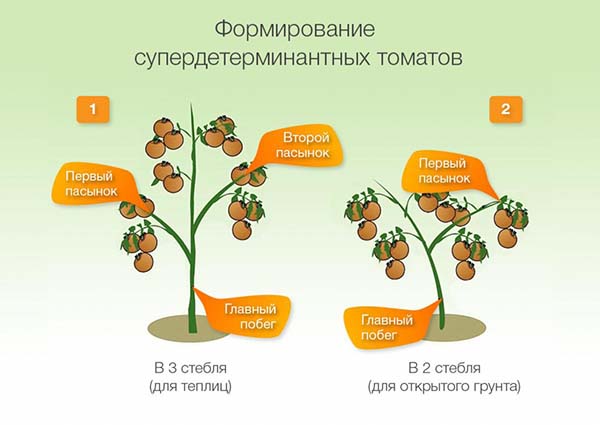
Low-growing tomatoes are formed in different ways, but mainly in 2 stems, and stronger and more powerful plants - in 3-4 stems.
- Need to remove all lower leaves before the first lateral shoot (there are usually about 2-3 of them).
- Also subject to removal all bottom stepsons (they can be removed completely without leaving even hemp), as a rule, somewhere 2-3, to the first formed flower brush.
- The last stage is the rationing of the crop, we need leave 5-7 (maximum - 8) brushes.
Of course, do not forget and about preventive treatments for late blight and other diseases (especially if you grow outdoors).
Video: undersized tomatoes - formation, tying, protection against diseases
As for agricultural technology, any tomatoes like dry and hot weather (up to + 30-35 degrees). In such conditions, they hardly get sick (especially phytophthora) and grow well. Naturally, you need to water only with warm water and it is necessary to water it at the root.
By the way! On our website you can find detailed articles on growing and caring for tomatoes:
- Seed preparation and treatment before sowing.
- Sowing seeds for seedlings and rules for its (seedling) cultivation before planting in the ground.
- Picking seedlings.
- Top dressing seedlings.
- What to do, if seedlings turn yellow.
- Why leaves become purple.
- How to prevent black leg.
- Planting seedlings in open ground: when and how to plant and look after (general article).
- When and how to plant seedlings in a greenhouse and take care of (general material).
- At what distance to plant (landing pattern).
- How to tie bushes.
- rules glaze.
- Top dressing of tomatoes in the greenhouse.
- How to deal with a whitefly in the greenhouse.
- How to deal with late blight.
- How to collect seeds.
The best low-growing varieties of tomatoes: top 25
Note! The list of the best low-growing tomatoes was prepared based on the degree of popularity of the names of varieties and hybrids, an analysis of the reviews of experienced gardeners, as well as the personal opinion of the author.
The best varieties of low-growing tomatoes (alphabetically):
Balcony miracle
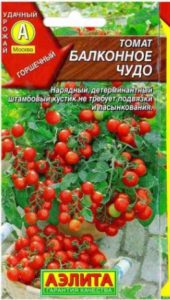
- Early ripening variety. Begins bearing fruit in 100 days after germination (according to other sources, after 90).
- The plant is determinate, standard, 30-40 cm high. No garter or pinching is required.
- For growing outdoors, as well as on a windowsill or balcony.
- The fruits are round, smooth, red. They look like cherries.
- Weight - about 15 grams (according to other sources - 20-30 grams).
- Productivity - 4-5 kg per square meter (according to other sources - 3.5-4.5 kg).
- Excellent sweet taste and aroma. For fresh consumption and canning.
- Resistant to late blight.
By the way! There is a similar variety with lemon yellow fruits.
White filling 241
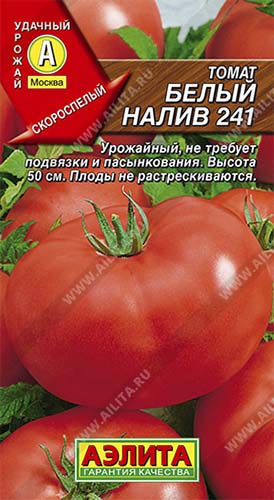
- Early ripening variety. From germination to maturation - 90-100 days in the open field, 80-90 - indoors.
- The plant is determinate, medium-sized, medium-leafy, up to 50 cm high (usually 30-40 cm), does not require pinching and garter. The first inflorescence is laid over the 6th leaf. There are 4-6 fruits in a bunch.
- Fruits are round-flat, smooth, slightly ribbed, red. The number of sockets is 5-12.
- Weight - 80-130 grams.
- Productivity - 5-8 kg per square meter (according to other sources, 3.8-9 kg).
- For fresh consumption and preparation of salads.
- Resistant to cracking, cold-resistant. Moderately susceptible to macrosporiosis, susceptible to late blight.
Bonsai
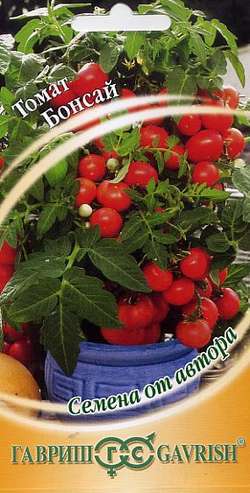
- Ultra early ripening variety (85-90 days from germination to fruiting).
- The plant is determinate, standard, dwarf (20-30 cm). No garter or pinning required. The first inflorescence is laid above the 5-6th leaf, then through 1 leaf (or even without separation by the leaf).
- Recommended for growing on a balcony, windowsill, in hanging flowerpots. Plants are planted in flower pots with a soil volume of 1.5-2.0 liters.
- The fruits are round, red. Number of slots 2.
- Weight - 20-25 g.
- Productivity - up to 0.5-1 kg per plant.
- High taste.
Brawler yellow
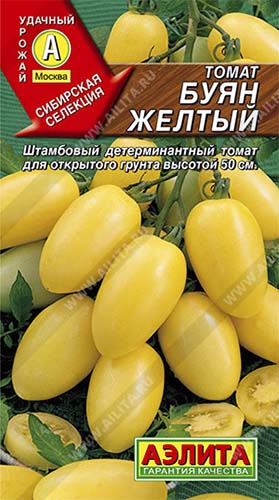
- Mid-season variety. Begins fruiting 110-115 days after germination.
- The plant is determinate, standard, strong, about 50 cm high.
- For open ground.
- Fruits are cylindrical, even, smooth, dense.
- Weight - 60-120 grams (up to 150 grams).
- Productivity - 2-5 kg per sq.m.
- The taste is pleasant (good or excellent), sweet with sourness.
- Mainly for fresh consumption, but also suitable for salting.
- Tolerant to adverse weather conditions. The fruits ripen well and are well stored.
Brawler is sometimes called "The Fighter".
Grandee
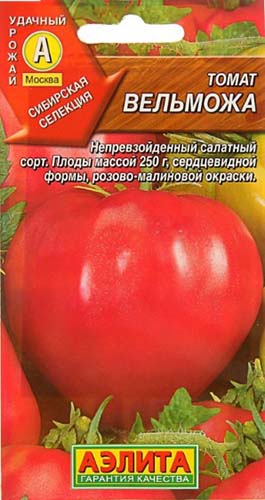
- Mid-season variety. Enters fruiting in 103-117 days after germination.
- The plant is determinate, 50-60 cm high. The inflorescence is complex. The first inflorescence is laid above 7-8 leaves, the next ones - after 1-2 leaves.
- For open ground and temporary cover films.
- The fruit is heart-shaped, medium-silvery, crimson. Number of nests 4 or more.
- Weight - 130-250 grams.
- Productivity - 8 kg per sq.m.
- Fruits of good or excellent taste, juicy, sugary. Salad destination.
The second name of the variety is "Budenovka".
Explosion
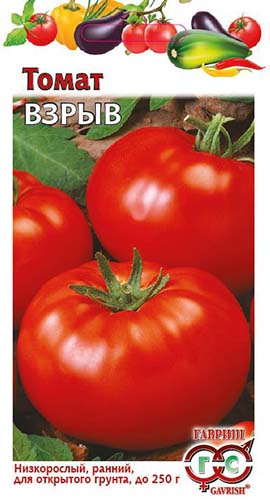
- Early ripe variety, 100-105 days from germination to fruiting (according to other sources, after 93-100 days).
- The plant is determinate, undersized, 45-60 cm high. Does not require pinching or moderate pinching.
- For growing in open ground and with film shelters.Recommended for areas of unstable farming.
- The fruit is round, slightly ribbed, of medium density, red. The number of nests is more than 6.
- Weight - 100-150 g, the first - up to 250 g.
- Productivity - up to 2.5-3 kg per plant (or 4.1 kg per square meter).
- The taste is good, aromatic.
- Universal use: for fresh consumption and conservation.
- Tolerant to adverse weather conditions. Cold resistant. Drought tolerant... Resistant to top and root rot.
Gnome
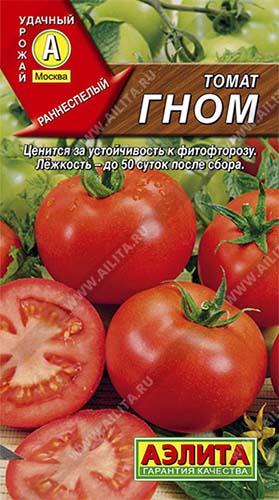
- An early maturing variety, the period from germination to ripening is 98-100 days (according to other sources, 91-116 days).
- The plant is determinate, semi-spreading, slightly branched and medium-leafy, 45-50 cm high, does not require garters and shaping. The first inflorescence is laid above 6-7 leaves, the next ones - after 1-2 leaves.
- Recommended for growing in open field and film shelters.
- The fruits are round, smooth. The number of nests is 2-3.
- Weight - 30-60 g.
- Excellent taste: sweet, juicy fruit. Designed for fresh consumption, whole-fruit canning, juicing and tomato paste.
- Productivity - 5-6 kg per sq.m.
- Medium susceptible to late blight of vegetative mass, resistant to macrosporiosis. Resistant to adverse weather conditions. The fruits do not crack, they are stored up to 50 days after harvest.
Summer resident
The characteristics of the variety in the company "Poisk" and "Sedek" are different (the characteristics of "Sedek" are given in brackets).
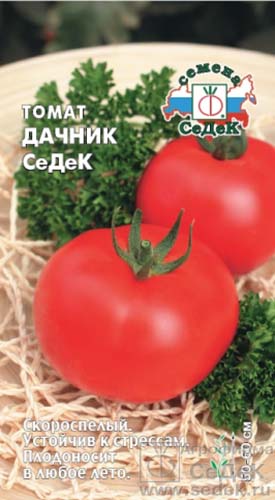
- Early maturing variety. The period from germination to the beginning of ripening is 95-115 days (according to other sources, 95-100 days).
- The plant is determinate, semi-spreading, medium-branched, medium-leafy. Height 40-55 cm (according to other sources, 50-60 cm). There are 4 to 6 fruits in a cluster.
- For open ground and film shelters.
- Fruits are flat-rounded, smooth, slightly ribbed, red. The number of nests (chambers) is more than 4.
- Weight - 60-100 g (according to other sources, 130-180 grams).
- Productivity - 2.5-3.5 kg per sq. meters (according to other sources, 4.8-5.6 kg per square meter).
- Good or excellent taste.
- Universal purpose. Recommended for fresh consumption, canning and processing into tomato products (tomato juice).
- Resistant to cold temperatures and fruit cracking, fusarium and apical rot.
Can be grown using a seedless method.
Demidov
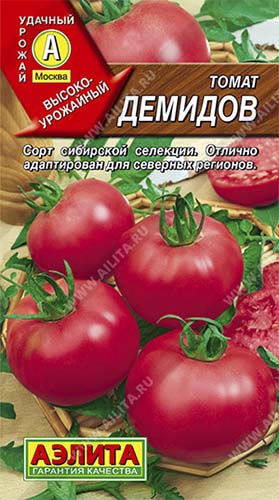
- Mid-season variety. Comes into fruiting after 100-110 days from mass shoots.
- The plant is determinate, standard erect, weakly branched, medium-leafy, 60-65 cm high. The first inflorescence is laid above 6-7 leaves, the next ones - after 1-2 leaves.
- For outdoor cultivation. Suitable for Siberia.
- Fruits are roundish, bright pink, fleshy. The number of nests is more than 4.
- Weight - 80-120 g,
- Outdoor yield is high - 4-5 kg per sq. m.
- Taste good and excellent, pleasant aroma.
- Designed for fresh consumption.
- Fruits are perfectly tied with sharp temperature fluctuations, they are well ripened.
Note! With uneven moisture, the fruits crack, with a lack of moisture, they are affected by apical rot.
Gina TST
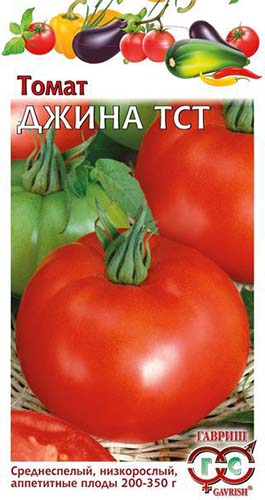
- Mid-season variety. Ripens 100-117 days after germination (according to other sources, after 110-115 days).
- The plant is determinate, medium-branched, 35-60 cm high. Does not require pinching.
- Requires garter and shaping.
- For open ground and film shelters.
- The fruit is round, slightly ribbed, bright red. The number of nests (chambers) is 6 or more.
- Weight - 200-350 grams.
- Productivity - up to 10 kg per square meter.
- The taste is excellent (harmonious). Universal purpose: for fresh consumption and for processing (salting, tomato juice).
- Resistant to cracking, verticillium and fusarium.
Long-term fruiting (until frost).
Dubrava
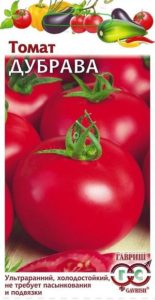
- Ultra early ripening variety. 85-105 days from germination to fruit ripening.
- The plant is determinate, compact, slightly branched and medium-leaved, 40-60 cm high. Does not require pinching and garter. The first inflorescence is laid above 6-7 leaves, the next ones - after 1-2 leaves.
- For open ground.
- The fruit is round, smooth, very dense, red. The number of slots is 3-6.
- Weight - 50-110 g.
- Productivity - up to 5.5 kg per sq.m.
- Fleshy, has a pleasant (good) sweet and sour taste. Universal purpose.
- Resistant to late blight. Cold hardy - suitable for growing in northern regions and in areas located in open, blown places).
Golden heart
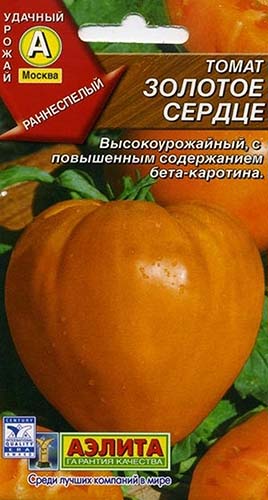
- Ultra early ripening variety (fruit ripening 80-85 days after full germination).
- The plant is determinate, strong bush, 30-40 cm high. Brush with 5-7 fruits. Requires moderate pinching.
- For open ground and film shelters.
- The fruit is heart-shaped, slightly ribbed, orange. The number of nests is more than 4.
- Weight - 100-130 grams.
- Productivity - up to 7 kg per sq.m.
- Excellent taste. With a high content of beta-carotene.
- Universal purpose: for fresh consumption and processing.
- Resistant to major diseases of culture.
Caspar F1
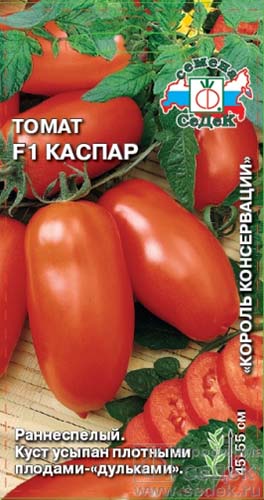
- Early ripe hybrid (93-95 days).
- The plant is determinate, 45-55 cm high. It requires moderate pinching.
- For open ground and film shelters.
- Fruits are elongated, pepper-shaped-cylindrical with a "spout", red, with a dense, well-detachable skin.
- Weighing 120-140 g.
- Productivity - up to 9-10 kg per sq.m.
- Great taste. Can be used both for salad and for processing. Recommended for canning, especially in its own juice and pickling. And when canning, the fruits retain a high density (you can cut them into slices!).
- Resistant to verticillium and fusarium wilting, as well as cracking. Possesses good keeping quality and transportability.
Broody
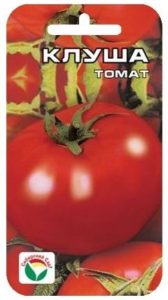
- Medium early grade. From germination to fruiting - 100-105 days.
- Standard bush, stable, undersized, up to 50 cm high, does not require pinching.
- For open ground.
- The fruits are red and round.
- Weight - up to 150 g.
- Fruits are universal, tasty both fresh and canned.
- The crop is hidden under the leaves at the back of the bush.
Super Cluff
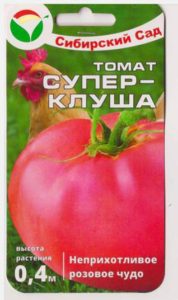
- Medium early grade. From germination to fruiting - 100-105 days.
- Standard bush, stable, undersized, up to 30-40 cm high, does not require pinching (formation).
- For open ground.
- Fruits are pink, rounded.
- Weight - 150-250 g.
- Productivity - up to 10 kg per sq.m.
- Fruits are universal, tasty both fresh and canned.
- Interesting! The crop is hidden under the leaves at the back of the bush.
Cranberries in sugar
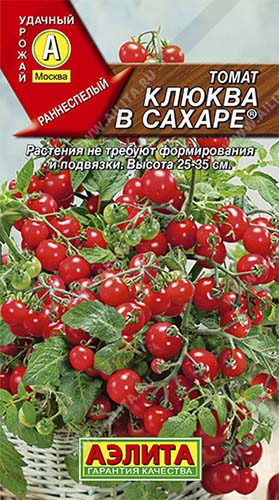
- Early maturing variety.
- The plant is determinate, standard, 25-35 centimeters high, does not require formation and garter.
- For growing in open ground, film greenhouses and indoor conditions (on a windowsill or balcony).
- Fruits are small, round, sweet, dark red. The number of sockets is 2-3.
- Weight - 15 grams.
- Productivity - 2.3-2.8 kg per sq.m.
- The fruits are tasty, juicy, sweet, ideal for making salads and canning whole fruits.
- Resistant to late blight and adverse weather conditions.
Little Red Riding Hood
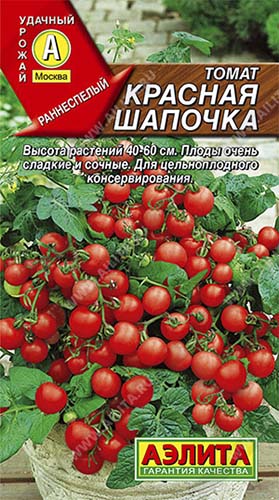 An early ripe cherry variety. From germination to the beginning of fruiting 85-90 days.
An early ripe cherry variety. From germination to the beginning of fruiting 85-90 days.- The plant is determinate, standard, 40-60 cm high. Does not require formation.
- Recommended for open ground, plastic greenhouses, balconies and window sills.
- The fruit is round, smooth, red. The number of sockets is 2-3.
- Productivity - 2-3 kg per sq. meters.
- Weight - 15-20 grams.
- The taste is excellent, sweet, juicy. Suitable for salads and whole fruit canning.
- Resistant to verticillium, fusarium wilt, tobacco mosaic virus.
Lazy
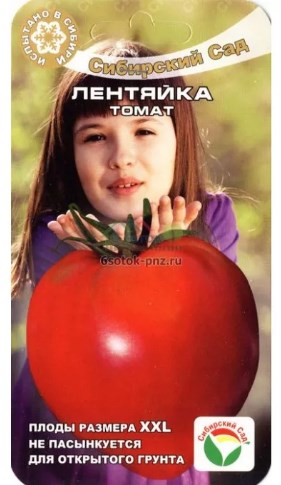
- Early variety (95-100 days).
- The plant is determinate, undersized, 40-50 tall. Sonnets up to the 1st hand. The main stem is edged at a height of about 0.5 m, a bountiful harvest of fruits is formed on a large number of lateral stepchildren.
- For growing in the open field and under film shelters.
- The fruit is heart-shaped, medium density, medium silvery,red. The number of nests is more than 6.
- Weight - an average of 300 g, the first - up to 600 grams.
- Productivity - up to 4 kg per plant.
- The taste is excellent (delicate sugary pulp). Salad destination.
Liang
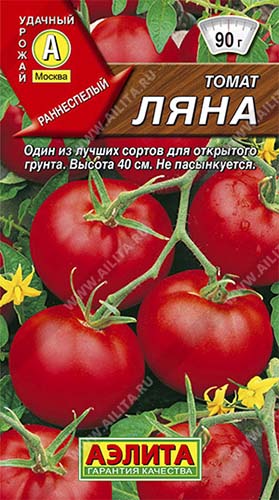
- Early maturing variety. From germination to fruiting 94-110 days.
- The plant is determinate, medium-branched, well leafy, 35-40 cm high. The first inflorescence is laid above 5-6 leaves, the subsequent ones - after 1-2 leaves. Requires moderate pinching (according to other sources, does not pinch).
- For open ground and film shelters.
- The fruit is round, smooth, red.
- Weight 65-90 g.
- Productivity - 6-7 kg per sq.m.
- Fresh fruits have excellent taste. Ideal for whole fruit canning.
- Resistant to top rot of fruits, bacterial spotting, macrosporiosis. Susceptible to tobacco mosaic virus.
Mongolian dwarf
Interesting! If earlier it was possible to purchase seeds only through “second hands”, now they are already selling seeds (“Uralsky Dachnik” and “Russian Garden”).
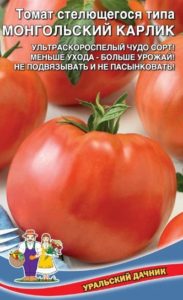
- Early maturing variety.
- The plant does not form a central (upright) stem. 4-5 stems grow from the root collar, which immediately fall on the ground, that is, a creeping bush (about 20-40 cm high), which means that you need to plant seedlings at a sufficient distance, at least 60 cm, or better - 1 meter. You don't need to tie up and tie up, but you can.
- For outdoor use, but can also be grown in a greenhouse.
- Weight - 100-200 grams.
- Productivity - 5-8 kg per bush.
- The taste is ordinary (tomato, sour). Universal purpose.
- It is quite resistant to late blight. Begins to be amazed late, only when the cool autumn nights come, and the defeat is relatively weak.
Fruiting until the frost.
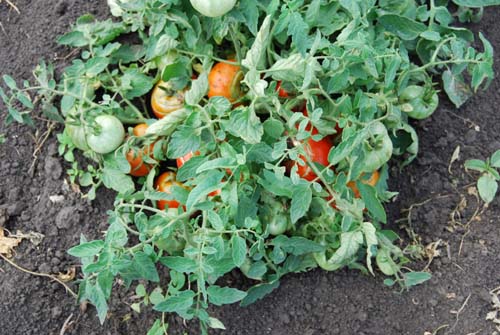
Video: proven tomato variety - Mongolian dwarf
Moskvich
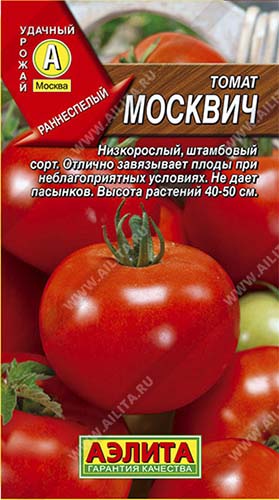 Early maturing variety. From germination to ripening 100-105 days (according to other sources, 95-110 days).
Early maturing variety. From germination to ripening 100-105 days (according to other sources, 95-110 days).- The plant is determinate, standard, 40-50 cm high (according to other sources, 30-40).
- For outdoor cultivation.
- The fruits are round, smooth, fleshy, red.
- Weight -55-75 g.
- Productivity - 1.5-4.5 kg per sq.m.
- The taste is excellent, the tomatoes are sweet and juicy. Suitable for fresh consumption, all types of culinary processing and whole fruit preservation.
- Resistant to unfavorable conditions (sudden temperature changes), fusarium, verticillus wilting, alternaria. The fruit does not crack.
Newbie
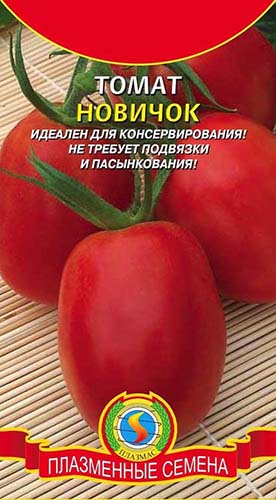
- Medium early grade. From germination to fruiting 110-114 days (according to other sources, 114-127 days).
- The plant is determinate, compact, medium-branched, medium-leafy, 50-85 cm high.
- The first inflorescence is laid above 6-7 leaves, the next ones - after 1-2 leaves.
- For growing in open ground and film shelters.
- The fruit is oval, smooth and firm, orange-red.
- Weight - 75-105 grams.
- Productivity - 5-6 kg per sq. m (according to other sources 4.2-5.5 kg).
- Great taste. Universal purpose. Taste qualities of fresh fruits - 4.0-4.6 points, whole-canned - 4.4 points, tomato juice - 4.2 points.
- Resistant to overripe, mechanical damage, high transportability.
- Resistant to root-knot nematode.
Note! Despite the fact that one thing is written on the packs, some sources indicate that a mandatory garter, shaping (1-2 stems) and pinching are required.
Orange
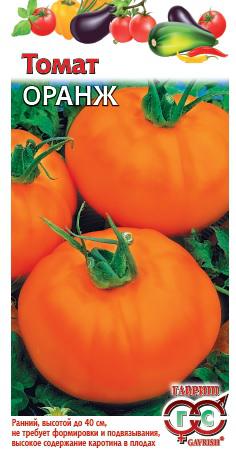
- Early ripe variety (97-103 days from germination to fruiting).
- The plant is determinate, semi-spreading, medium-leafy, 35-40 cm high. Does not require shaping and tying. The first inflorescence is laid above 6-7 leaves, the next ones after 1-2 leaves.
- For growing in the open field and under film shelters.
- The fruit is flat-round, smooth, orange,
- Weight - 90-100 g,
- Productivity - 4.9-6.2 kg per sq.m.
- Universal use: for fresh consumption, preparation of salads and whole-fruit preservation. High in beta-carotene,
- Resistant to top and root rot.
Petrusha Ogorodnik
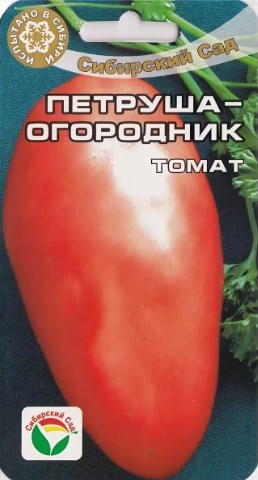
- Medium early variety.
- The plant is determinate, standard, undersized, 50-60 cm high. It practically does not require pinching.
- Recommended for growing in open field and film shelters.
- The fruit is oval-elongated (cylindrical with a pointed apex), smooth, medium density, crimson (pink). The number of nests is 6 or more.
- Weight - up to 200 g (average 150-180 g).
- Productivity - 4-6 kg per sq.m.
- The fruits are fleshy, sugary, very tasty both fresh and canned.
Pinocchio
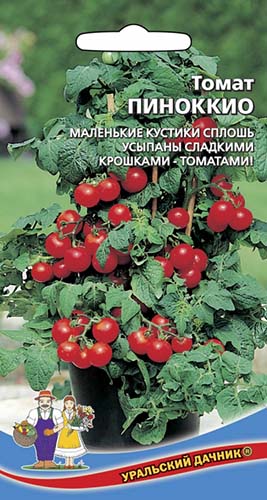
- Mid-season variety. 105-110 days from germination to fruiting.
- The plant is determinate, standard, compact, 20-35 cm high.
- Recommended for growing on a windowsill indoors, on a balcony or in the open field.
- The fruit is flat-round, smooth, red. The number of sockets is 2-3.
- Weight - 15-20 g.
- Productivity - 1-1.5 kg per plant.
- Good or excellent taste. Universal purpose.
Button
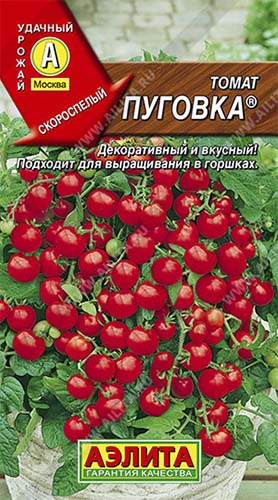
- Early ripening variety.
- The plant is determinate, standard, 50-60 cm high.
- For open ground and plastic greenhouses. Also suitable for growing in pots at home (on a balcony or windowsill).
- The fruit is round, smooth, red. The number of sockets is 2-3.
- Weight - 10-15 grams.
- Productivity - 4.0-4.5 kg per sq.m.
- Very sweet and aromatic, with excellent taste.
- Ideal for home cooking, preparing and decorating salads, baby food, diet food, and whole-fruit canning.
- Resistant to verticillosis, fusarium wilt.
Pink honey
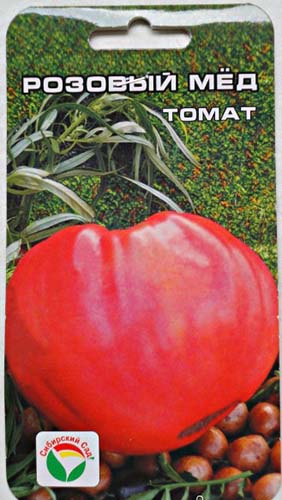
- Mid-season variety. From germination to fruiting 100-120 days (on average - after 115 days).
- The plant is determinate, weakly growing, 60-70 cm high, with a high load of heavy fruits. It should be grown in 2-3 stems with a garter.
- For open ground and film shelters.
- Fruits are truncated heart-shaped, deep pink in color with a moire tint.
- Weight - from 400 to 1500 grams.
- Productivity - more than 6 kg per bush.
- The taste is excellent. For fresh consumption, home cooking and market sales.
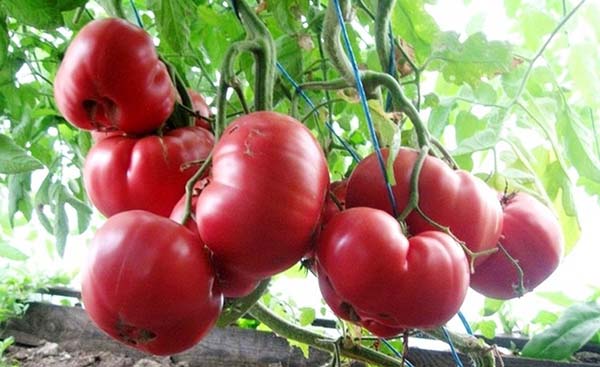
Sanka
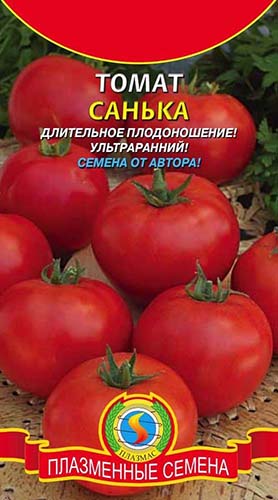
- Ultra early ripening variety. From germination to harvesting 75-85 days (according to other sources 78-85 days).
- The plant is determinate, 40-60 cm high, does not pick up.
- The first inflorescence is laid over the 7th leaf (according to other sources, over the 5-6th leaf), the subsequent ones - after 1-2 leaves.
- For growing in open and closed ground (greenhouse).
- The fruit is round, slightly ribbed, red. Number of nests (chambers) 3-4.
- Weight - 80-100 grams in the open field, up to 150 grams in the greenhouse.
- Productivity - 13-15 kg per sq. m (according to other sources up to 5-10 kg).
- The taste is good and excellent. The tomato is sweet, juicy and fleshy.
- Universal use: for fresh consumption, canning and preparation of tomato juice.
- Resistant to low light and low temperatures. The fruits are resistant to cracking.
Long-term fruiting (until frost).
Siberian troika
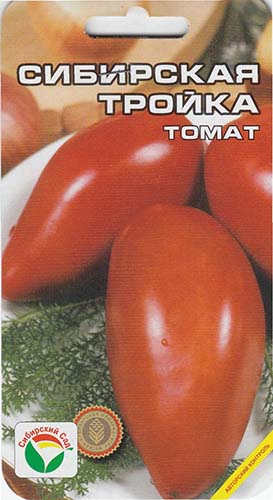
- Medium early grade.
- The plant is determinate, with a compact standard type of bush, up to 60 cm high. The first inflorescence is laid over 9 leaves, the subsequent ones - after 1-2 leaves. Virtually no pinching required.
- For open ground and film shelters.
- Fruits are red, bright, regular pepper-shaped, large. The number of sockets is 3-4.
- Weight - 80-100 g (up to 200 g). The first fruits are up to 15 cm long, weighing up to 350 g.
- The taste and sweetness of the fleshy fruits, which do not even require salt when consumed fresh, can be called the "highlight" of this variety.
- Productivity - up to 5 kg per plant, or an average of 6 kg per square meter.
- Resistant to many tomato diseases. Heat resistant.
Shuttle
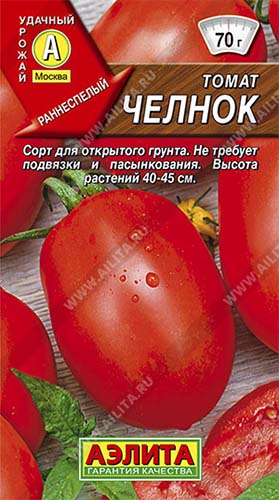
- Early maturing variety.From germination to fruit ripening - 82-110 days.
- The plant is determinate, standard, erect, weakly branched and medium-leafy, 40-45 cm high, does not require pinching and garter. The first inflorescence is laid above 6-7 leaves, the next ones - after 1-2 leaves.
- For open ground.
- The fruit is oblong-oval (apex with a spout), smooth, red. The number of sockets is 2-3.
- Weight - 50-70 grams.
- Productivity - 5-8 kg per sq.m.
- Good taste. Universal purpose.
- It is relatively resistant to late blight.
Yamal 200
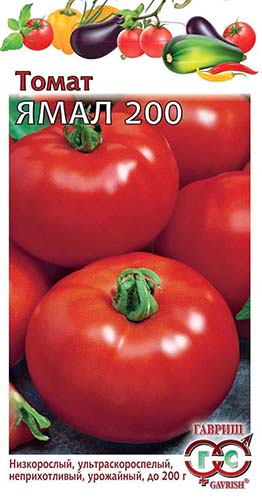
- Super early ripening variety (83-98 days).
- For open ground and film shelters. Suitable for seedless cultivation in northern regions and areas of risky farming.
- The plant is indeterminate, standard, 25-35 cm high. As a rule, it does not require garter and pinching, but stepchildren must be removed to obtain a super early harvest.
- The fruit is round (flat-round), slightly ribbed, red.
- Weight - 65-105 grams (maximum up to 180-200 grams).
- Productivity - up to 9-12 kg per square meter (indoor), or up to 3-3.5 kg per plant.
- Good taste. Universal purpose: fresh consumption and canning.
- Resistant to stress (low temperatures), insufficient illumination, "gives off" the yield until late blight appears. Resistant to top and root rot.
Other popular undersized varieties
Naturally, in addition to the varieties described above, there are many, albeit a little less popular (quite popular ones are dressed in bold), but quite proven and worthy undersized tomatoes (alphabetically):
- Agatha;
- Watercolor;
- Alaska;
- Ballerina;
- Betta;
- Betalux;
- Boney MM;
- Grushovka;
- Children's sweetness;
- Riddle;
- Golden Stream;
- Siberian early ripening;
- Bullfinches;
- Supermodel;
- Heavyweight of Siberia;
- Duckling;
- Amber;
In general, having evaluated all the advantages and disadvantages of determinant tomatoes, now you must correctly decide on the choice of the most suitable varieties for your greenhouse and plot. At the same time, focus your attention on yields, ripening times, palatability, appearance and disease resistance. Good luck!
Video: 10 best low-growing tomato varieties

